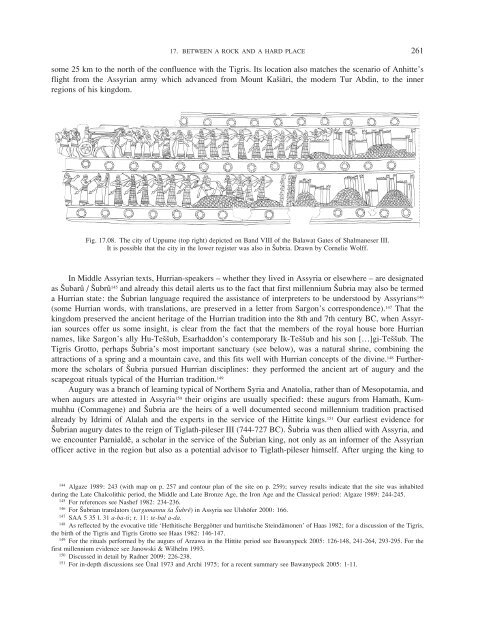Download PDF version of article - UCL
Download PDF version of article - UCL
Download PDF version of article - UCL
Create successful ePaper yourself
Turn your PDF publications into a flip-book with our unique Google optimized e-Paper software.
17. BETWEEN A ROCK AND A HARD PLACE 261<br />
some 25 km to the north <strong>of</strong> the confluence with the Tigris. Its location also matches the scenario <strong>of</strong> Anhitte’s<br />
flight from the Assyrian army which advanced from Mount Kasiari, the modern Tur Abdin, to the inner<br />
regions <strong>of</strong> his kingdom.<br />
Fig. 17.08. The city <strong>of</strong> Uppume (top right) depicted on Band VIII <strong>of</strong> the Balawat Gates <strong>of</strong> Shalmaneser III.<br />
It is possible that the city in the lower register was also in Subria. Drawn by Cornelie Wolff.<br />
In Middle Assyrian texts, Hurrian-speakers – whether they lived in Assyria or elsewhere – are designated<br />
as Subarû / Subrû 145 and already this detail alerts us to the fact that first millennium Subria may also be termed<br />
a Hurrian state: the Subrian language required the assistance <strong>of</strong> interpreters to be understood by Assyrians 146<br />
(some Hurrian words, with translations, are preserved in a letter from Sargon’s correspondence). 147 That the<br />
kingdom preserved the ancient heritage <strong>of</strong> the Hurrian tradition into the 8th and 7th century BC, when Assyrian<br />
sources <strong>of</strong>fer us some insight, is clear from the fact that the members <strong>of</strong> the royal house bore Hurrian<br />
names, like Sargon’s ally Hu-Tessub, Esarhaddon’s contemporary Ik-Tessub and his son […]gi-Tessub. The<br />
Tigris Grotto, perhaps Subria’s most important sanctuary (see below), was a natural shrine, combining the<br />
attractions <strong>of</strong> a spring and a mountain cave, and this fits well with Hurrian concepts <strong>of</strong> the divine. 148 Furthermore<br />
the scholars <strong>of</strong> Subria pursued Hurrian disciplines: they performed the ancient art <strong>of</strong> augury and the<br />
scapegoat rituals typical <strong>of</strong> the Hurrian tradition. 149<br />
Augury was a branch <strong>of</strong> learning typical <strong>of</strong> Northern Syria and Anatolia, rather than <strong>of</strong> Mesopotamia, and<br />
when augurs are attested in Assyria 150 their origins are usually specified: these augurs from Hamath, Kummuhhu<br />
(Commagene) and Subria are the heirs <strong>of</strong> a well documented second millennium tradition practised<br />
already by Idrimi <strong>of</strong> Alalah and the experts in the service <strong>of</strong> the Hittite kings. 151 Our earliest evidence for<br />
Subrian augury dates to the reign <strong>of</strong> Tiglath-pileser III (744-727 BC). Subria was then allied with Assyria, and<br />
we encounter Parnialdê, a scholar in the service <strong>of</strong> the Subrian king, not only as an informer <strong>of</strong> the Assyrian<br />
<strong>of</strong>ficer active in the region but also as a potential advisor to Tiglath-pileser himself. After urging the king to<br />
144 Algaze 1989: 243 (with map on p. 257 and contour plan <strong>of</strong> the site on p. 259); survey results indicate that the site was inhabited<br />
during the Late Chalcolithic period, the Middle and Late Bronze Age, the Iron Age and the Classical period: Algaze 1989: 244-245.<br />
145 For references see Nashef 1982: 234-236.<br />
146 For Subrian translators (targumannu sa Subrê) in Assyria see Ulshöfer 2000: 166.<br />
147 SAA 5 35 l. 31 a-ba-ti; r. 11: te-bal a-da.<br />
148 As reflected by the evocative title ‘Hethitische Berggötter und hurritische Steindämonen’ <strong>of</strong> Haas 1982; for a discussion <strong>of</strong> the Tigris,<br />
the birth <strong>of</strong> the Tigris and Tigris Grotto see Haas 1982: 146-147.<br />
149 For the rituals performed by the augurs <strong>of</strong> Arzawa in the Hittite period see Bawanypeck 2005: 126-148, 241-264, 293-295. For the<br />
first millennium evidence see Janowski & Wilhelm 1993.<br />
150 Discussed in detail by Radner 2009: 226-238.<br />
151 For in-depth discussions see Ünal 1973 and Archi 1975; for a recent summary see Bawanypeck 2005: 1-11.

















